
views
Filing Alphabetically

Decide on the alphabetical system you will use. Even something as seemingly straightforward as alphabetical filing offers several options to choose from. It is important that you choose one system and use it consistently. Letter-by-letter filing considers each letter in each word in the order of appearance, ignoring any spaces between words. Word-by-word filing orders items based on the first letter of each word in succession. Unit-by-unit filing takes into account each word, abbreviation, and initial, ordering items according to these. The unit-by-unit system is generally recommended.
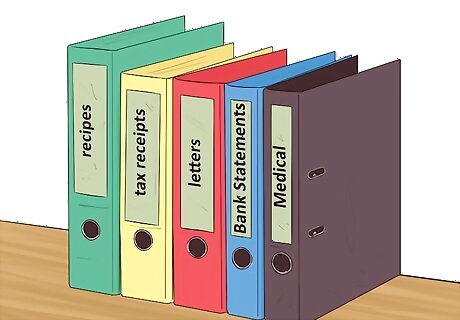
Group items. Once you have all of the items you need to file, decide how you want to group the files. You can choose the dictionary format, in which all files are put in one alphabetical order, regardless of the type of file or the items it contains. You can also use the encyclopedia format, in which items are grouped by type or subject, and then each group is alphabetically arranged. If you have lots of different types of items to file (recipes, tax receipts, letters, etc.), then it can be helpful to use the encyclopedia format. Group the items by type first, then alphabetically order the items in each group. Keep the groups separated using dividers or color coding.

Index your files. Indexing is the manner of placing each section of a title in the correct unit. To index items before filing them, you must break down the elements of each item’s name and create a new alphabetized name, which may differ from the standard name. For example: Suppose you have the following items to index and file: an article on aardvarks titled “Nocturnal Feeding of Aardvarks,” a biography of noted aardvark expert Jane A. Doe, and a promotional brochure for a Detroit Zoo aardvark exhibit. The biography of Jane A. Doe would be indexed as “Doe, Jane A.," since last names come first in filing. It would be filed under the letter “D.” The article “Nocturnal Feeding of Aardvarks” could be indexed as-is, if you choose dictionary-style grouping. It could be filed under the letter “N” (for “Nocturnal”), using this grouping. Alternatively, you could index “Nocturnal Feeding of Aardvarks” as “Aardvarks, Nocturnal Feeding of.” This would make sense if you were using an encyclopedia-style grouping, and not just filing items related to aardvarks. The item would then be filed under “A.” The promotional brochure could be indexed as “Aardvarks, exhibits (Detroit Zoo)." This would make sense if you expect to have several materials on aardvark exhibits—for example, you might have another item to be indexed as “Aardvarks, exhibits (Toledo Zoo).” Alternatively, the promotional brochure could be indexed as “Detroit Zoo (Aardvark Exhibit)." This might make sense if you expect to have several items related to the Detroit Zoo, or if you want to use an encyclopedia-style grouping to file items by geographic location.

Order files alphabetically according to their indexed name. The general rule for filing alphabetically is to arrange items in order from A (first) to Z (last). Use increasingly specific information to distinguish between and order separate items. For instance: The order of your indexed files in the previous step could then be (depending on the system you use): “Doe, Jane A.,” “Detroit Zoo (Aardvark Exhibit),” and “Nocturnal Feeding of Aardvarks” OR “Aardvarks, exhibits (Detroit Zoo),” “Aardvarks, Nocturnal Feeding of,” and “Doe, Jane A.” A file for “Wallaby” would come after a file for “Emu.” A file for “Kangaroo” would come in between, and a file for “Aardvark” would come before one for “Bear” and one for “Emu.” This would give you the following file order: "Aardvark," "Bear," "Emu," "Kangaroo," "Wallaby." If you then added a file for “Anteater,” it would come after any files for “Aardvark.” Since both begin with the letter “A,” you have to look at the second letter of each word (“N” and “A,” respectively) to determine the order, and then arrange files based on this. The new order would be: "Aardvark," "Anteater," "Bear," "Emu," "Kangaroo," "Wallaby."

Label your file folders. To make it easy to locate items, label each file folder with the proper indexed name of the item(s) it contains. This will also make it easier to introduce new files in the proper order. Place items in the folder designated for them. You may also find it useful to color code your files to improve usability. For instance, if you are using an encyclopedia-style grouping, give each group a separate color, and label each item/file in each group with its respective color.

Document the indexing and filing system. Be consistent with your indexing and filing system, whatever it is. Ensure anyone with access to the files is aware of the system. For instance, you can create and share a document that details your filing system rules. This will help everyone be able to use the filing system efficiently.

File new items properly. Place files in the cabinet based on the indexed names and alphabetical order, according to the system you use. Shift the current files as needed to place new files in the correct place.
Dealing With Special Cases
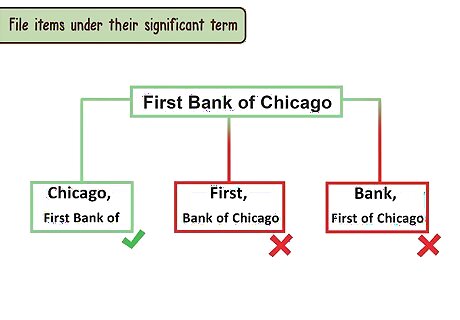
File items under their significant term. Sometimes, it makes sense to file items based on key words, regardless of the order that words in a title or name appear. This ensures that a file can be indexed and located using the most logical term. For instance “First Bank of Chicago” could be indexed and filed as “Chicago, First Bank of.” “Chicago” is the key term in this entry, rather than “First” or “Bank,” especially if you might have other items with similar names, such as “First Bank of Tulsa” or “Chicago Bank and Trust.”
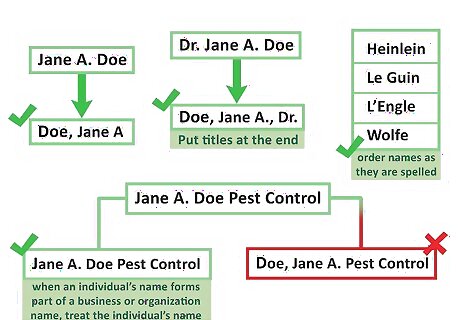
Order names by surname. Typical filing standards recommend indexing individuals by last name first, since the surname is considered the significant term. Thus, “Jane A. Doe” would be indexed and filed as “Doe, Jane A.” Put titles (Dr., Mrs., Major, etc.) at the end. “Dr. Jane A. Doe,” for instance, would be indexed and filed as “Doe, Jane A., Dr.” Generally, order names as they are spelled, letter-by-letter. For instance, “MacDonald” would come before “McDonald.” Likewise, “D’,” “L’,” “Le,” “de,” etc. are considered as part of name, not separate units For instance, order files “Heinlein,” “Le Guin” “L’Engle,” and “Wolfe” in that order (and NOT as “L’Engle, “Le Guin,” “Heinlein,” “Wolfe”). A common exception to these rules about names is when an individual’s name forms part of a business or organization name. In these cases, treat the individual’s name as units within the business name. For instance, “Jane A. Doe Pest Control” would be filed under “J,” and NOT indexed as “Doe, Jane A. Pest Control.”

Ignore articles, conjunctions, and prepositions. Articles (such as “a,” “an,” and “the”), conjunctions (such as “and,” “but,” and “or”), and prepositions (such as “for,” “of,” and “in”) are generally skipped when indexing and filing alphabetically, since they are not considered significant terms. This is the case even when they form the beginning of an item’s name. For instance: “An Investigation of Emu Feeding Practices” would be in filed under “E,” for “Emu” (the significant word in this item’s title), rather than “A” for “an.” “Doe and Smith Pest Control” would be filed after “Doe, Jane A.” Both indexed names begin with the word “Doe,” so you move on to the next significant term in each (“Smith” and “Jane,” respectively) to determine the file order. Ignore the word “and,” since it is not significant.
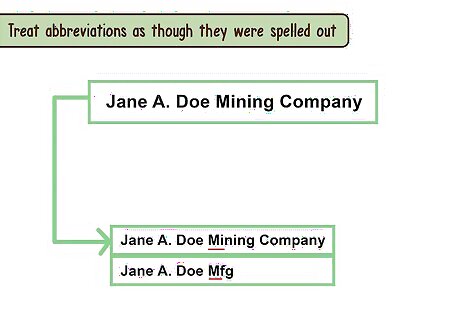
Treat abbreviations as though they were spelled out. When indexing and filing items, you may encounter abbreviations such as “Mfg.” (for “Manufacturing”) or “Inc.” (for “Incorporated). Generally, you should index and file items as though these abbreviations were spelled out, rather than simply as strings of letters. For instance, “Jane A. Doe Mining Company” would be filed after “Jane A. Doe Mfg.”

File numerals ordinarily. While filing items alphabetically, you may encounter numerals within their titles. Generally, file numbers ordinarily, rather than as if they were spelled out. Numbers are also filed before letters. For instance, “3M Company” would be filed before “100 Great Business Ideas” (since “3” comes before “100”). “Great Business Ideas” and “Great Business Leaders” would be filed after “100 Great Business Ideas,” since numbers are arranged before letters. Numbers that are already spelled out are treated as words, rather than numerals. For instance, file items “100 Great Business Leaders,” “Great Business Ideas,” and “Two Hundred Great Business Ideas” in that order. If it serves your filing purposes, however, you can make an exception and always file numerals as though they were spelled out.
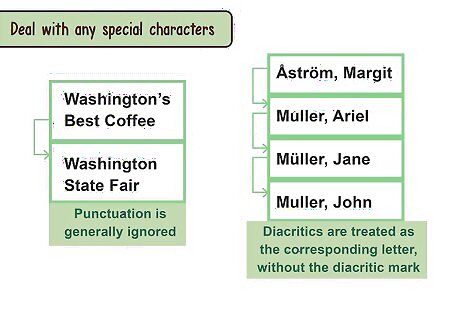
Deal with any special characters. Any non-alphabetical or non-numeric characters that you encounter when indexing and filing items must be taken into account. What to do with these characters, however, depends on their type: Punctuation (such as apostrophes, periods, and commas) is generally ignored when indexing and filing items. For instance, file “Washington’s Best Coffee,” and “Washington State Fair” in that order. Diacritics are treated as the corresponding letter, without the diacritic mark. For example, file “Éclair” as “Eclair,” and “Über” as “Uber.” The exception to this is when you are filing according to the alphabet of a language that uses diacritics, in which case you should follow the normal alphabetical order of that language.

Use the general rule “nothing before something” when necessary. Generally, spaces (including punctuation and other elements that are skipped) are ignored when filing alphabetically. However, in cases where you have items that begin the same way, use a space or the rule "nothing before something" to determine the filing order. For instance, file “North East Bank,” “North East Manufacturing” and “Northeast Bank,” in that order. Likewise, "Doe, Jane A." would be filed before "Doe, Jane A., Dr."
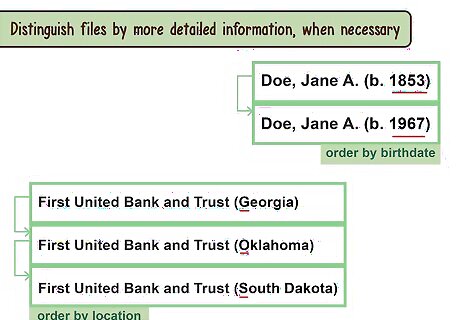
Distinguish files by more detailed information, when necessary. In rarer cases, alphabetic information is not enough to determine the order of files. In these cases, you must utilize further information to index and order items. Mark this additional information on the respective files to help you distinguish them. For instance: If you had items for two different individuals named Jane A. Doe, you could order them by birthdate. File “Doe, Jane A. (b. 1853)” would thus come before file “Doe, Jane A. (b. 1967). You could also order items according to geography when you need to make distinctions. If you have files for three different banks in three different locations, and each bank is called “First United Bank and Trust,” you could order them alphabetically in the order “First United Bank and Trust (Georgia)”, “First United Bank and Trust (Oklahoma),” and “First United Bank and Trust (South Dakota).” Likewise, if you had items for two different bears or types of bears, you would distinguish them further, based on species, geographic location, etc. For instance, you might have files on “Bear, Brown” and “Bear, Grizzly” (in that order), or files on "Bears (European)" and “Bears (North American)” (in that order).

Publicize exceptions and special rules. Make sure that everyone who uses your files knows about any exceptions to standard guidelines that are factored into your filing system. This will help ensure that everyone can use the filing system properly and efficiently.




















Comments
0 comment